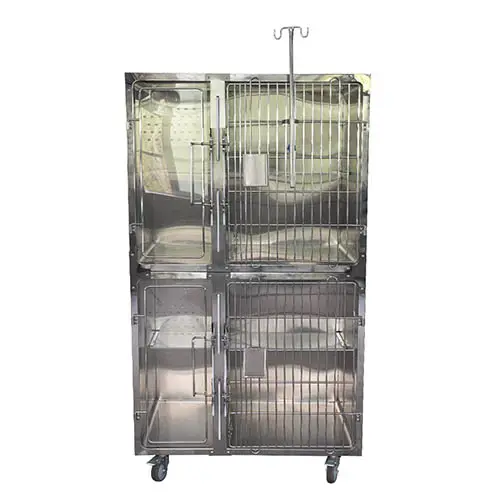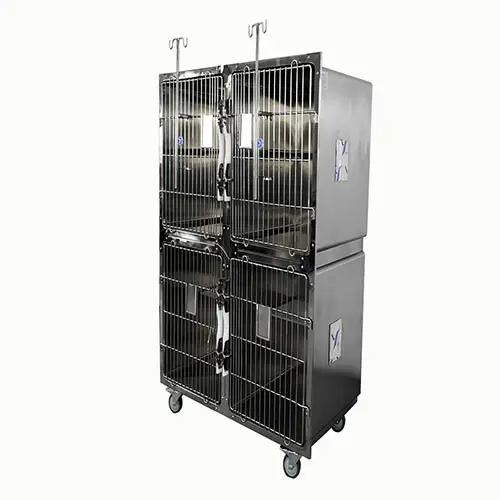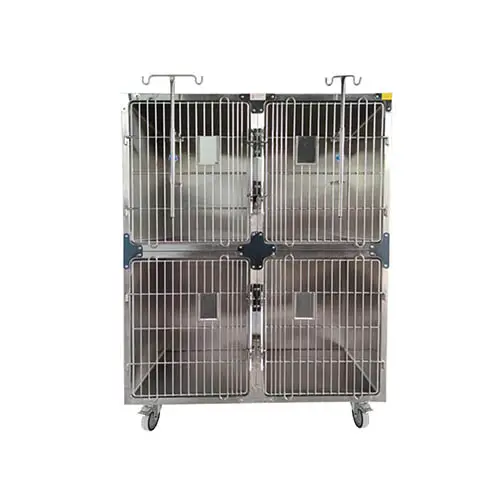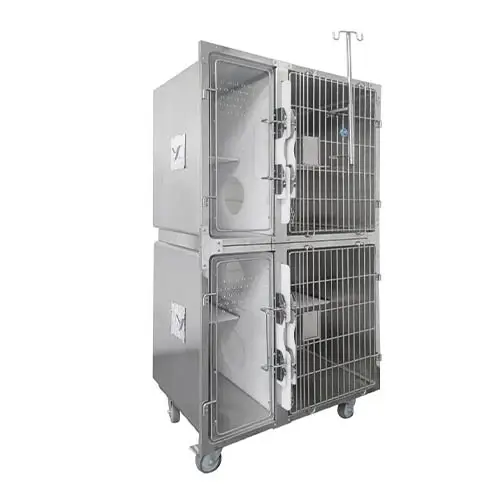Adresse
304, rue Cardinal Nord
Centre Dorchester, MA 02124
Heures de travail
Du lundi au vendredi : 7h - 19h
Week-end : 10h - 17h
Bienvenue sur mon blog !
Avant de plonger dans le contenu, j'aimerais que vous me rejoigniez sur mes plateformes de médias sociaux où je partage plus d'informations, interagis avec la communauté et publie des mises à jour. Voici comment vous pouvez me contacter :
Facebook :https://www.facebook.com/profile.php?id=100071234835011
LinkedIn :https://www.linkedin.com/company/74943205/admin/dashboard/
YouTube :www.youtube.com/@shandongexpertmedicalequip4695
TikTok :www.tiktok.com/@expertmedical
Commençons maintenant notre voyage ensemble. J'espère que vous trouverez le contenu ici instructif, engageant et utile.

In the demanding environment of a veterinary clinic, the choice of equipment can significantly impact the efficiency of operations and the well-being of animal patients. Among the most critical pieces of equipment are veterinary cages, particularly those constructed from stainless steel. Stainless steel veterinary cages are renowned for their durability, hygiene, and ease of maintenance, making them a preferred choice for many veterinary professionals. This guide aims to provide a comprehensive overview of the key considerations when selecting the right stainless steel veterinary cages for your practice.
Stainless steel veterinary cages offer numerous advantages that make them a superior choice for animal care facilities. First and foremost, stainless steel is highly resistant to corrosion and rust, ensuring longevity and durability even in environments with frequent exposure to moisture and cleaning agents. This material is also non-porous, preventing the absorption of bacteria and odors, which is crucial for maintaining a hygienic environment. Moreover, stainless steel is easy to clean and disinfect, reducing the risk of cross-contamination and promoting a healthy environment for animals.
The inherent strength and durability of stainless steel make it an ideal material for veterinary cages. These cages can withstand the rigors of daily use, including the scratching and biting of animals. Furthermore, stainless steel is resistant to dents and scratches, maintaining its aesthetic appeal and structural integrity over time. This longevity translates to a cost-effective investment, as stainless steel veterinary cages require minimal maintenance and replacement.
Maintaining a clean and sanitary environment is paramount in veterinary clinics. Stainless steel veterinary cages excel in this aspect due to their smooth, non-porous surface. This surface prevents the accumulation of dirt, debris, and pathogens, making cleaning quick and efficient. Simple wiping with a disinfectant solution is often sufficient to maintain hygiene standards. Additionally, stainless steel is compatible with a wide range of cleaning agents, including harsh chemicals, without the risk of damage or degradation.


Selecting the right stainless steel veterinary cages involves careful consideration of several factors to ensure they meet the specific needs of your practice.
The size and configuration of the cages should be tailored to the size and species of animals you treat. Larger animals, such as dogs and cats, require spacious cages that allow them to move comfortably. Smaller animals, such as rodents and birds, may require smaller, specialized cages. Consider the layout of your clinic and the available space to determine the optimal configuration of cages. Some cages offer modular designs, allowing for customization and expansion as needed.
The construction and design of stainless steel veterinary cages play a crucial role in their functionality and safety. Look for cages with sturdy frames, secure latches, and smooth edges to prevent injuries to animals and staff. The design should also facilitate easy access for cleaning and animal handling. Features such as removable doors, dividers, and trays can enhance convenience and efficiency.
Adequate ventilation is essential for maintaining air quality and preventing the buildup of odors and moisture. Stainless steel veterinary cages should be designed with proper ventilation systems, such as perforated panels or mesh doors. Effective drainage systems are also crucial for managing liquids and waste. Look for cages with sloped floors and drainage holes to facilitate easy cleaning and prevent the accumulation of fluids.
Depending on your clinic’s needs, mobility and customization options may be important considerations. Cages with casters or wheels can be easily moved for cleaning or rearranging the layout. Customization options, such as adjustable shelves, lighting, and heating elements, can enhance the comfort and functionality of the cages.
| Caractéristique | La description | Avantage |
|---|---|---|
| Matériel | High-grade stainless steel | Durability, corrosion resistance, hygiene |
| Taille | Various sizes and configurations | Accommodates different animal sizes and species |
| Construction | Sturdy frame, secure latches, smooth edges | Safety, durability, ease of use |
| Ventilation | Perforated panels, mesh doors | Air quality, odor control |
| Drainage | Sloped floors, drainage holes | Easy cleaning, waste management |
| Mobilité | Casters, wheels | Easy movement and rearrangement |
| Personnalisation | Adjustable shelves, lighting, heating elements | Enhanced comfort and functionality |
Proper maintenance and care are essential for maximizing the lifespan and performance of stainless steel veterinary cages. Regular cleaning and disinfection are crucial for preventing the spread of infections and maintaining a hygienic environment.
Cleaning should be performed daily to remove debris, waste, and spills. Use a mild detergent or disinfectant solution and a soft cloth or sponge to wipe down the surfaces of the cages. Pay special attention to corners, crevices, and areas that come into contact with animals. Rinse thoroughly with clean water and dry the cages to prevent water spots and corrosion.
While stainless steel is highly resistant to corrosion, it is still susceptible to damage from harsh chemicals and abrasive cleaners. Avoid using bleach, ammonia, or other corrosive substances. Inspect the cages regularly for signs of wear and tear, such as scratches, dents, or loose parts. Repair or replace damaged components promptly to maintain the integrity of the cages.

Choosing a reputable supplier is crucial for ensuring the quality and reliability of your stainless steel veterinary cages. Look for suppliers with a proven track record, positive customer reviews, and comprehensive warranties. Consider suppliers that offer customization options and after-sales support.
Research the supplier’s reputation and experience in the industry. Look for testimonials and reviews from other veterinary professionals. Inquire about their manufacturing processes, quality control measures, and customer service policies. A reputable supplier should be transparent and responsive to your inquiries.
A comprehensive warranty provides peace of mind and protection against defects or malfunctions. Inquire about the warranty coverage and duration. Evaluate the supplier’s after-sales support, including installation, maintenance, and repair services. A reliable supplier should be committed to customer satisfaction and provide timely assistance.
Stainless steel veterinary cages are an essential investment for any veterinary clinic. Their durability, hygiene, and ease of maintenance make them a superior choice for animal care facilities. By considering the key factors outlined in this guide, you can select the right cages to meet the specific needs of your practice and ensure the well-being of your animal patients.
Q: What are the main benefits of using cages vétérinaires en acier inoxydable?
A: Stainless steel veterinary cages offer durability, corrosion resistance, hygiene, and ease of cleaning.
Q: How do I choose the right size and configuration of cages?
A: Consider the size and species of animals you treat, as well as the available space in your clinic.
Q: How do I maintain and care for cages vétérinaires en acier inoxydable?
A: Clean and disinfect the cages regularly with a mild detergent and avoid using harsh chemicals.
Q: Are stainless steel cages suitable for all types of animals?
A: Yes, stainless steel cages can accommodate a wide range of animals, from small rodents to large dogs.
Notifications
